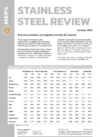German economic woes subdue Europe’s recovery hopes
Germany has transitioned from being a powerhouse of Europe’s stainless steel market to a handicap for a region targeting recovery.
MEPS’s German stainless steel coil prices declined for a second consecutive month in August as Europe’s summer holiday period weighed on already subdued domestic demand. Germany’s reduced productivity is applying downward pressure to prices across the region, however.
Germany’s GDP declined by 0.2% in 2023. Having recovered, to achieve growth of 0.2% in quarter one of 2024, the latest economic data indicates a 0.1% decline in Germany’s GDP in quarter two.
MEPS respondents bemoaned the loss of a traditional export market during August’s subdued trading period. One Italian supplier said that it had suffered a reduction in sales to what had been the “leading industrial customer of Italian industry for at least the last 20 years”.
Germany’s stainless steel import and export activity has been in decline since 2021. The country’s annual import volumes fell by 22.0% to 1.68 million tonnes, between 2021 and 2023, as exports declined by 14.4% to 638,524 tonnes.
Downturn in construction and manufacturing
Europe’s largest economy has been particularly hard hit by a downturn in its construction sector – a key consumer of stainless steel. Elevated interest rates have stalled investment in a sector that accounts for around a fifth of the country’s economic output. As of the end of July, new construction starts in Germany were down by 26% year-to-date. The construction sector has now been in contraction for 28 months.
According to the Hamburg Commercial Bank’s (HCOB) Germany Construction PMI, further contraction is anticipated. The PMI improved from 39.7 in June to 40.0 in July, edging above France (39.7) to end 12 months as Europe’s worst performing construction sector.
Germany’s flagship automotive sector has also slowed in 2024. The German Association of the Automobile Manufacturers (VDA) reported a 9% year-on-year decline in car production in July (to 350,200 units). Production is now down by 6% year-to-date, at 2.1m units – 16% below pre-Covid 2019.
The HCOB Germany Manufacturing PMI has lagged behind other major European economies since January 2023, dipping as low as 38.8 in July that year. In July, the Manufacturing PMI declined for a second consecutive month, falling from 45.4 to 43.2 in the period since May.
Subdued market outlook
The outlook for European stainless steel producers targeting export sales to German customers remains subdued. Eurostat, the statistical office of the EU, forecasts that Germany’s GDP will grow by 0.1% in 2024.
Nonetheless, the German coalition government’s approval of a long-awaited 2025 budget, on July 17, should improve sentiment. The plan, which aims to add 0.5 percentage points of GDP growth, includes a record EUR78bn allocated to investments, including new infrastructure projects. EUR57bn will be invested to expand the country’s renewable energy infrastructure in 2025.
An increase in renewable energy projects will bring an uptick in steel demand and could also reduce energy costs for the country’s steelmakers. After a subdued summer trading period MEPS respondents say that there is little expectation of a short-term recovery in stainless steel demand. Any plan that brings hope of an improvement in the longer term is likely to be welcomed across Europe.

Source:
Stainless Steel Review
The MEPS Stainless Steel Review is an invaluable monthly guide to international stainless steel prices and includes the latest global stainless steel industry analysis.
Go to productRequest a free publication





